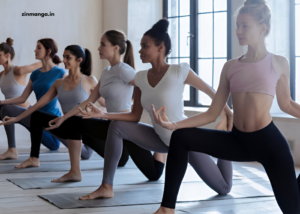In the ever-evolving world of health and wellness, staying ahead of the curve is essential for those who aim to achieve a well-balanced and active lifestyle. As technology advances and new research on fitness emerges, we are witnessing the rise of cutting-edge fitness trends that revolutionize how we approach exercise, recovery, and overall health. These trends not only enhance physical performance but also focus on the mental, emotional, and social aspects of living an active life.
For individuals seeking to improve their fitness or take their current routine to the next level, understanding these innovations can be the key to unlocking new levels of wellness. In this article, we will explore the latest fitness trends for active living, delving into high-tech gadgets, alternative fitness routines, and holistic approaches to staying fit and healthy. If you’re looking to elevate your fitness game, this guide will offer valuable insights to keep you at the forefront of the fitness world.
The Rise of Virtual Fitness and Online Workouts
One of the most notable trends in recent years is the growth of virtual fitness platforms and online workouts. Thanks to advancements in technology, fitness enthusiasts now have access to a wide variety of online workout classes and virtual trainers from the comfort of their own homes. From yoga and pilates to high-intensity interval training (HIIT) and strength training, there’s no shortage of workout options available via apps, streaming services, and live virtual platforms.
Benefits of Virtual Fitness:
- Convenience: You can access workouts anytime, anywhere, without the need for a gym membership or commute.
- Variety: The diversity of workouts ensures that there’s something for everyone, no matter their fitness level or preferences.
- Personalization: Many online platforms offer personalized fitness plans, allowing users to customize their routines based on their goals, preferences, and progress.
- Affordability: Virtual fitness options are often more cost-effective than traditional gym memberships.
Platforms such as Peloton, Nike Training Club, and Beachbody on Demand are just a few examples of services that have gained immense popularity in the virtual fitness space. These services offer live and on-demand classes with professional trainers, making it easier to maintain a regular exercise routine and stay motivated. Additionally, the social aspect of these platforms helps foster a sense of community, keeping individuals engaged and connected.
Wearable Fitness Technology
Wearable fitness technology has become an indispensable part of modern active living. Devices such as smartwatches, fitness trackers, and heart rate monitors allow individuals to track their workouts, monitor health metrics, and set goals to enhance performance. These gadgets provide real-time data, empowering users to make informed decisions about their fitness routines and overall health.
Popular Wearables:
- Apple Watch: Known for its seamless integration with fitness apps, the Apple Watch provides users with personalized workout recommendations, heart rate tracking, and activity monitoring.
- Fitbit: A leader in fitness trackers, Fitbit offers a range of devices designed to track steps, sleep patterns, calorie burn, and heart rate, giving users a holistic view of their activity levels.
- Whoop Strap: Unlike traditional fitness trackers, Whoop focuses on recovery by monitoring strain, sleep, and recovery metrics, offering users data-driven insights to optimize performance.
Wearables not only track physical activity but also allow individuals to monitor vital health metrics such as blood oxygen levels, stress, and sleep quality. This integration of health and fitness monitoring makes wearables a key player in the cutting-edge fitness movement, providing users with comprehensive tools to improve their well-being.
Functional Fitness and Movement-Based Training
In recent years, functional fitness has gained traction as a fitness trend. This training method focuses on exercises that mimic everyday movements, enhancing strength, flexibility, balance, and endurance. Unlike traditional weight training, which isolates specific muscles, functional fitness emphasizes whole-body movements that improve overall functional capacity.
Key Elements of Functional Fitness:
- Multidimensional Movements: Exercises such as squats, lunges, push-ups, and kettlebell swings engage multiple muscle groups, promoting overall strength and coordination.
- Core Strength: A strong core is essential for maintaining posture, balance, and stability during everyday activities.
- Agility and Flexibility: Functional fitness routines incorporate exercises that improve range of motion, mobility, and flexibility, which can prevent injuries.
Some of the most popular functional fitness activities include CrossFit, kettlebell training, TRX suspension training, and resistance band workouts. These exercises focus on strength, endurance, agility, and flexibility, allowing individuals to improve their fitness levels in a way that directly translates to real-world movements. By incorporating functional training into their routines, active individuals can boost their overall performance and reduce the risk of injury.
Recovery and Mobility: Prioritizing Rest and Rejuvenation
As fitness becomes more intense and demanding, the importance of recovery has become more apparent. Recovery techniques, including stretching, foam rolling, and muscle activation, are integral to maintaining long-term physical health and preventing overuse injuries. Recent trends have emphasized the importance of incorporating recovery practices into fitness regimens, ensuring that the body has the time and tools to heal and rebuild.
Popular Recovery Techniques:
- Foam Rolling: Using a foam roller to release muscle tension and improve flexibility.
- Cryotherapy: Cryotherapy involves using cold temperatures to reduce muscle inflammation and promote recovery.
- Infrared Saunas: These saunas use heat to penetrate the skin, improving circulation, reducing muscle soreness, and promoting relaxation.
- Massage Guns: Percussive therapy devices like Theragun provide targeted relief to tight muscles and enhance recovery.
In addition to physical recovery, mental health and relaxation techniques are also gaining popularity. Practices such as mindfulness, meditation, and yoga have been integrated into active living routines to help individuals manage stress, improve mental clarity, and enhance overall well-being. These practices not only support physical recovery but also promote a balanced approach to health.
HIIT and Micro Workouts for Time Efficiency
For many individuals, time constraints often hinder their ability to commit to long workout sessions. Enter High-Intensity Interval Training (HIIT), a cutting-edge fitness trend that focuses on short bursts of intense exercise followed by brief rest periods. HIIT workouts can be completed in as little as 20-30 minutes, making them ideal for busy individuals who want to maximize their workout in minimal time.
Benefits of HIIT:
- Efficiency: HIIT workouts provide maximum calorie burn and cardiovascular benefits in a short period.
- Metabolism Boost: These workouts elevate the metabolic rate, promoting fat burning even after the workout is completed.
- Variety: HIIT can be adapted to various fitness levels and preferences, including bodyweight exercises, cycling, running, and strength training.
Micro workouts, another trend gaining momentum, also focus on short bursts of activity. These exercises can be as brief as 5-10 minutes and are designed to be easily incorporated into daily routines. Micro workouts focus on maximizing intensity in a short time frame, allowing individuals to stay active throughout the day without committing to long workout sessions.
Personalized Nutrition and Supplements
Another cutting-edge trend that complements active living is personalized nutrition. As fitness and wellness become more individualized, the focus is shifting toward tailored nutrition plans that complement specific fitness goals. Companies and apps are now using advanced algorithms and genetic testing to provide customized nutrition recommendations based on an individual’s unique needs, preferences, and health data.
Key Components of Personalized Nutrition:
- Macronutrient Adjustments: Personalized plans focus on adjusting the balance of carbohydrates, proteins, and fats to support different fitness goals, such as muscle building, fat loss, or endurance.
- Micro-Nutrients and Supplements: Active individuals are now incorporating supplements that cater to their specific needs, including protein powders, vitamins, minerals, and probiotics.
By taking a personalized approach to nutrition and supplementation, individuals can optimize their performance, recovery, and overall well-being. Combining personalized nutrition with an active fitness routine ensures that the body receives the right nutrients at the right time, maximizing energy, strength, and performance.
Sustainable Fitness Practices
Sustainability has become an important factor in many aspects of modern life, including fitness. As environmental concerns rise, fitness enthusiasts are turning to eco-friendly products, sustainable gym gear, and sustainable workout practices. This trend not only promotes environmental consciousness but also aligns with the values of a growing segment of active individuals who seek to minimize their carbon footprint.
Eco-Friendly Fitness Products:
- Recycled Yoga Mats: Many yoga mats are now made from eco-friendly materials like TPE (thermoplastic elastomer) or recycled rubber, which are both sustainable and durable.
- Sustainable Activewear: Brands are creating fitness apparel using sustainable materials such as organic cotton, bamboo, and recycled polyester.
- Reusable Water Bottles: Staying hydrated during workouts is essential, and many fitness enthusiasts are opting for reusable water bottles to reduce single-use plastic waste.
Sustainability in fitness also extends to outdoor activities such as hiking, cycling, and trail running, with individuals increasingly seeking to enjoy nature while preserving it. Engaging in outdoor fitness activities not only promotes physical health but also fosters a deeper connection with the environment.
Conclusion: Stay Ahead of the Fitness Curve
As the fitness landscape continues to evolve, staying up-to-date with cutting-edge trends ensures that you are maximizing your potential and maintaining a holistic approach to well-being. From virtual fitness platforms and wearable technology to functional training and sustainable practices, there are countless opportunities to embrace the future of fitness and active living. Whether you are looking to improve your performance, recover faster, or live a more balanced life, these trends provide the tools and knowledge necessary to achieve your health and fitness goals.
By integrating the latest Cutting-Edge Fitness innovations into your routine, you not only enhance your physical health but also promote mental and emotional well-being. In the pursuit of active living, the future is bright, and the possibilities are endless.








